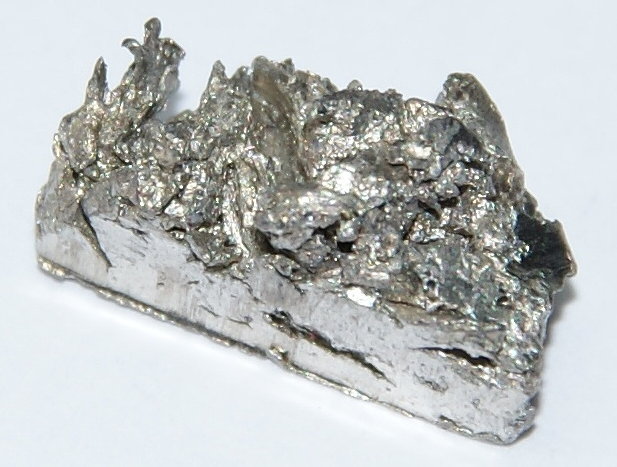Identity.
Ytterbium, the silvery element named after a Swedish village rich in
rare earths, dances between common and rare. More abundant than some
"common" elements, it still belongs to the "rare earth" lanthanides.
Soft and malleable, it surprises with its low density and magnetic
quirks. Shining in lasers and whispering promises for solar cells, its
multifaceted identity continues to intrigue scientists, revealing its
potential bit by bit.
Atomic Structure:
Ytterbium, atomic structure - Stock Image - C013/1626 ... The nucleus
consists of 70 protons (red) and 104 neutrons (blue). 70 electrons
(green) bind to the nucleus, successively occupying available electron
shells (rings). Ytterbium is a lanthanide in period 6, and the f-block
of the periodic table. It melts at 824 degrees Celsius.
History.
In 1878, Swiss chemist Jean Charles Galissard de Marignac explored the
element erbium, then believed to be pure. His meticulous work revealed
a hidden component, a white oxide he named "ytterbia," after its
birthplace, Ytterby, Sweden. This oxide held the key to ytterbium's
existence.
While "ytterbia" hinted at the presence of a new element, it
initially remained elusive. It wasn't until 1907 that Georges
Urbain, aided by others, separated it into two components:
"neoytterbium" and "lutecia." Neoytterbium later became known as
the element ytterbium, while lutecia became lutetium.
Early confusion led to the misspelling "ytterbium," but the name
stuck. Understanding its unique properties like low density and
malleability opened doors to specialized applications. Ytterbium
lasers now mark and engrave materials, while research holds
promise for its role in solar cells and other technologies. From a
hidden oxide to a versatile element, ytterbium's journey continues
to inspire scientific exploration and innovation.
Usage.
From laser maestro to catalyst champion and solar cell spark,
ytterbium shines bright in diverse ways. It empowers lasers to
precisely etch materials, drives cleaner chemical reactions, and
whispers promises of harnessing the sun's energy more efficiently.
This versatile element, once hidden within a Swedish village's mineral
treasure, continues to reveal its potential, shaping the future in
unexpected ways.
-
Laser Maestro: Ytterbium shines brightest in its role as
the active element in fiber lasers. These highly efficient lasers
offer long lifetimes and precise control, making them ideal for
various applications. They're used for intricate material
processing, marking and engraving delicate surfaces, and even
performing surgery with minimal tissue damage.
-
Catalyst Champion: Ytterbium compounds display remarkable
catalytic prowess in organic transformations. They offer cleaner
and more efficient alternatives to traditional catalysts, reducing
waste and environmental impact. Their versatility allows them to
be employed in various reactions, from polymer synthesis to
pharmaceuticals production, accelerating chemical processes and
enhancing sustainability.
-
Solar Cell Spark: Beyond lasers and catalysts, ytterbium
shows promising potential in solar cell technology. Its unique
ability to convert sunlight into electricity is being explored to
develop more efficient photovoltaic cells. This could contribute
significantly to clean energy solutions, harnessing the power of
the sun for a sustainable future.
Some of the benefits of using Ytterbium are:
-
Ytterbium-powered fiber lasers offer unparalleled accuracy and
control. Their focused beams minimize heat impact, making them
ideal for delicate procedures in surgery, material processing, and
intricate marking/engraving. This translates to higher efficiency,
reduced waste,
-
Ytterbium compounds act as powerful catalysts, accelerating
chemical reactions while requiring lower energy and producing less
waste. They contribute to sustainable practices in industries like
polymer synthesis and pharmaceutical production, leading to
cleaner and more resource-efficient processes.
-
Ytterbium holds promise for revolutionizing solar cells. Its
ability to convert sunlight into electricity efficiently could
lead to next-generation photovoltaic devices, contributing
significantly to renewable energy solutions and combating climate
change.
-
Ytterbium boasts exceptional stability, making it reliable and
durable for various applications. Fiber lasers offer long
lifespans and minimal maintenance, while ytterbium-based catalysts
remain active for extended periods, reducing the need for frequent
replacements and contributing to cost-effectiveness.
Sources.
While "rare" might be in its name, ytterbium isn't hiding as tightly
as you'd think. Its primary source is monazite, a common mineral found
in river sands worldwide. Although ytterbium makes up only around
0.03% of monazite, specialized techniques like solvent extraction and
ion exchange extract this versatile element. China currently leads in
ytterbium production, but other significant sources exist in the US,
Brazil, India, and Sri Lanka. So, next time you see a shimmering
riverbed, remember: tiny treasures like ytterbium might be nestled
within, waiting to be revealed and utilized for lasers, catalysts, and
even cleaner energy solutions.
Properties.
Magnestism Marvel: Unlike other lanthanides, ytterbium
exhibits unusual magnetic properties. It changes its "magnetic
personality" with temperature, being ferromagnetic (like a tiny
magnet) below freezing, antiferromagnetic (internal domains
anti-aligned) at cooler temperatures, and paramagnetic (susceptible to
external fields) above room temperature. This unique behavior holds
potential for diverse applications.
Laser Light Champion: Ytterbium boasts specific emission
properties ideal for high-performance lasers. These "ytterbium fiber
lasers" offer precise control and long lifetimes, making them
invaluable in material processing, marking/engraving delicate
surfaces, and even performing microsurgery with minimal tissue damage.
Caralytic Champion: Certain ytterbium compounds act as powerful
catalysts, significantly speeding up chemical reactions. They offer
cleaner and more efficient alternatives to traditional catalysts,
reducing waste and environmental impact. Their versatility allows them
to drive various reactions, from polymer synthesis to pharmaceuticals
production, contributing to sustainable and efficient chemical
processes.
